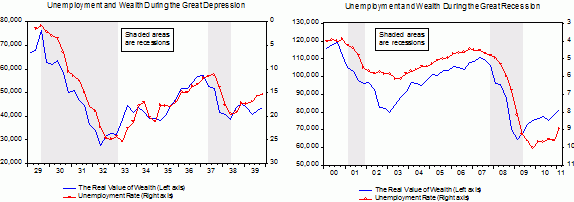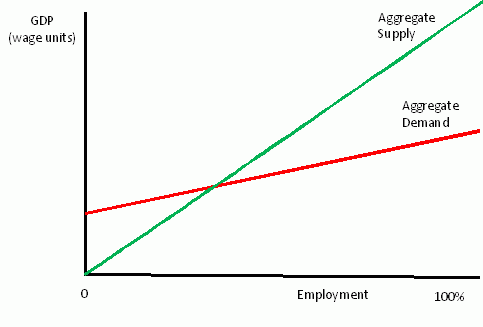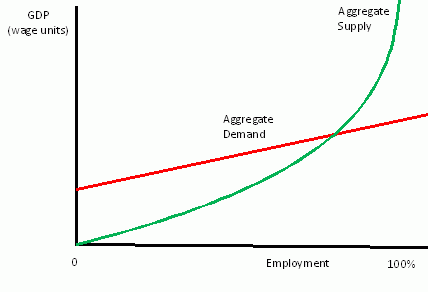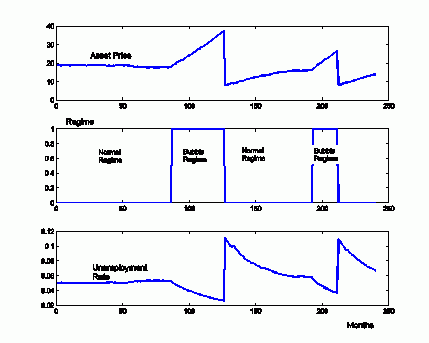According to a popular narrative (e.g. Shiller 2008), the Great Recession was caused by a bubble in the housing market. When the bubble burst, households were left with mortgages that exceeded the values of their houses. When they stopped spending, the resulting fall in consumer demand triggered an increase in unemployment. The drop in housing wealth was accompanied by a stock market crash, precipitated by the failure of Lehman Brothers in the fall of 2007.
Although this narrative fits the facts, it poses two major difficulties for conventional microeconomic theory.
- First, the existence of an asset price bubble is inconsistent with the theory of forward-looking rational agents interacting in markets (Santos and Woodford 1997).
- Second, conventional theory has no good explanation for why the bursting of an asset price bubble should be associated with the emergence of high and persistent unemployment.
In my research over the last decade (see Farmer 1999 to 2010) I have proposed a new paradigm that reconciles rational behaviour and high unemployment with microeconomic theory. In a recent paper (Farmer 2011), I extend my earlier work to explain asset price bubbles. I show that for every value of the stock market, there is a higher value that is consistent with a rational-expectations equilibrium. This cannot occur in conventional economic models in which there is a single rational value for an asset price.
This work opens the door to a class of theories that integrate market psychology with economics in a new way. Market psychology explains how the animal spirits of investors cause booms and crashes in asset values. The theory explains how asset price movements are translated into swings in the unemployment rate, by implication, provides an asset price management policy, as an alternative to conventional fiscal policy, to restore full employment.1
Wealth and unemployment in financial crises
Figure 1 compares the behaviour of US wealth and unemployment during the Great Recession with the same variables during the Great Depression. Wealth is represented by the blue line, measured on the left axis. Unemployment is the red line, measured on the right axis on an inverted scale.
The increase in unemployment during the 2007-2009 recession was preceded by a big drop in house prices, which fell 36% between 2006.Q1 and 2009.Q1. The wealth variable depicted in Figure 1 consists of 2/5 housing (represented by the Case-Shiller house price index) and 3/5 factories and machines (represented by the S&P 500 measured in wage units).2
Figure 1. Correlation between unemployment and wealth during the Great Depression and Great Recession
Aggregate demand and supply
My previous work on unemployment (Farmer 2009, 2010, 2011) is summarised by Figure 2, which plots employment on the horizontal axis and the value of GDP, measured in wage units, on the vertical axis. This is the same diagram described by Keynes in Chapter 3 of The General Theory (1936).
A version of this diagram was made popular by Samuelson (1955) in the third edition of his textbook and it was taught to several generations of students as the embodiment of Keynes' General Theory. But although Keynesian economics contains a relatively complete theory of the aggregate demand curve, Keynesians have had difficulty reconciling Keynes' concept of aggregate supply with microeconomic principles. The most sophisticated new-Keynesian theory of aggregate supply (Woodford 2003) is built around the idea that wages and or prices are sticky. This was never a central component of Keynesian economics and the fact that sticky wages or prices are central to his main thesis is explicitly denied by Keynes in Book V of The General Theory.
Figure 2.
Unlike Samuelson's interpretation of Keynesian economics that evolved into New Keynesian economics, my theory does not rest on the assumption that prices and wages are sticky. In my work, if demand remains low, high unemployment will persist as a steady-state equilibrium.
Rational bubbles
In theories in which rational forward-looking agents interact in asset markets, there will be a connection between the current value of assets and the expected value of future profits. In standard asset-pricing theory (Lucas 1978), beliefs about future fundamentals cause forward-looking individuals to change the amount that they are willing to pay for an asset.
In my version of asset-pricing theory, changing beliefs about the value of the stock market cause agents to demand more or less consumption goods as they become richer or poorer. As demand changes, so does the value of future profits; these changes in profitability make the original revision of beliefs about asset prices self-fulfilling.
In simple representative agent models with logarithmic preferences and Cobb-Douglas technology, the connection between the asset price and the value of economic activity can be summarised by an equation linking the stock market, to GDP,
Here, q is the value of the stock market, Y measures GDP and θ is a parameter. Both q and Y are measured in wage units.
In the theory, self-fulfilling beliefs cause q to increase or decrease based on the animal spirits of market participants. That causes the aggregate demand curve in Figure 2 to shift up or down and employment to increase or decrease in response.
For an explosive bubble to be rational there must be reason for forward-looking individuals to expect the price of an asset to keep increasing, however high the current price. It is for that reason that existing theories of bubbles are either bounded as in Kashiwagi (2010), or they drop some aspect of the rationality hypothesis as in Lansing (2010).
Figure 3.
In Farmer (2011) I generalise the assumptions about technology and preferences made in my previous work and show that, with these more general assumptions, the aggregate supply curve has the shape indicated in Figure 3. As employment approaches 100%, the value of GDP measured relative to the wage can become arbitrarily large. This property is important because it implies that there is no upper bound to the value of the stock market. However high the stock market rises, there is always an equilibrium in which it can increase further.
Economics and psychology
This brings me to the title of this article. I believe that group psychology can move markets. These movements are not purely transitory. If the real value of stock market wealth stays permanently low, the unemployment rate will stay permanently high.
In my rational bubbles article, I assume that bubbles in asset prices arise spontaneously from market psychology. If people believe that asset prices will rise, there is an equilibrium in which that belief is self-fulfilling. Bubbles collapse with some probability and, for a time, the economy enters a period of normal growth. A sample path from my model is depicted in Figure 4.
Figure 4.
This model explains why bubbles and crashes have such devastating effects on human welfare. A failure in the labour market arises from the absence of prices to direct firms to correctly allocate search time between unemployed workers and the recruiting departments of firms. The absence of price signals leads to equilibria in which unemployment may deviate forever from the social-planning optimum.
This explanation of bubbles is clearly stylised. The data suggest that the stock market is not independent of the real economy; there is a feedback loop from unemployment to stock prices. But the model captures an important idea: Market psychology is an independent driving force of the real economy. Importantly, this explanation of bubbles and crashes is consistent with the rational expectations hypothesis; they are rational bubbles.
Conclusion
The two most recent recessions look a lot more like the 1929 contraction than any of the other post-war recessions. Each of them was accompanied by a boom and subsequent bust in asset prices, a feature that was not present in the other nine post-war recessions. Why was a large collapse in asset prices accompanied by a big increase in the unemployment rate? Why was the recovery so slow in the 1930s and why was unemployment still at 9.2% in July of 2011, 25 months after the NBER declared an end to the recession? That requires a theory that can explain persistent unemployment and that is what I have contributed in my recent works by providing a new comprehensive and internally consistent paradigm in which any unemployment rate can persist as a steady-state equilibrium.
References
Farmer, Roger EA (1999), The Macroeconomics of Self-Fulfilling Prophecies, MIT Press, (1993) second edition, (1999).
Farmer, Roger EA (2008), “Aggregate Demand and Supply”, International Journal of Economic Theory, 4(1):77-94.
Farmer, Roger EA (forthcoming), “Confidence, Crashes and Animal Spirits”, NBER Working Paper No. 14846, (2009) Economic Journal (forthcoming)
Farmer, Roger EA (2010a), “Animal Spirits, Persistent Unemployment and the Belief Function”, NBER Working Paper No. 16522.
Farmer, Roger EA (2010b), Expectations, Employment and Prices, Oxford University Press.
Farmer, Roger EA (2010c), How the Economy Works: Confidence, Crashes and Self-fulfilling Prophecies, Oxford University Press.
Farmer, Roger EA (2011), “Animal Spirits, Rational Bubbles and Unemployment in an Old-Keynesian Model”, CEPR Discussion Paper, 8439.
Friedman, Milton (1957), A Theory of the Consumption Function, Princeton University Press.
Kashiwagi, Masanori (2010), “Search Theory and the Housing Market”, European University Institute, mimeo.
Keynes, John Maynard (1936), The General Theory of Employment, Interest and Money, MacMillan and Co.
Kevin J Lansing (2010), “Rational and Near-Rational Bubbles Without Drift”, Economic Journal, 549:1149-1174.
Lucas Robert E Jr. (1978), “Asset Prices in an Exchange Economy”, Econometrica, 46:1429-1445.
Ramey, Valerie A (2000), “Identifying government spending shocks; it's all in the timing”, mimeo, University of California San Diego.
Samuelson, Paul A (1955), Economics: An Introductory Analysis,(3rd Ed.), McGraw Hill.
Taylor, John B (2000), “Reassessing Discretionary Fiscal Policy”, Journal of Economic Perspectives, 14(3):21-36.
Santos, Manuel S and Michael Woodford (1997), “Rational Asset Pricing Bubbles”, Econometrica, 65(6):19-58.
Shiller, Robert J (2008), The Subprime Solution: How Today's Financial Crisis Happened, and What to Do about it, Princeton University Press.
Woodford, Michael (2003), Interest and Prices: Foundations of a Theory of Monetary Policy, Princeton University Press.
1 “A New Fiscal and Monetary Policy for Economic Stability", Plenary Address at the Society for Computational Economics, San Francisco Fed, July 2011,. This address will be published in an upcoming volume of the Journal of Economic Dynamics and Control.
2 This way of deflating the series removes both the nominal trend that arises from inflation and the real trend that arises from GDP growth.







